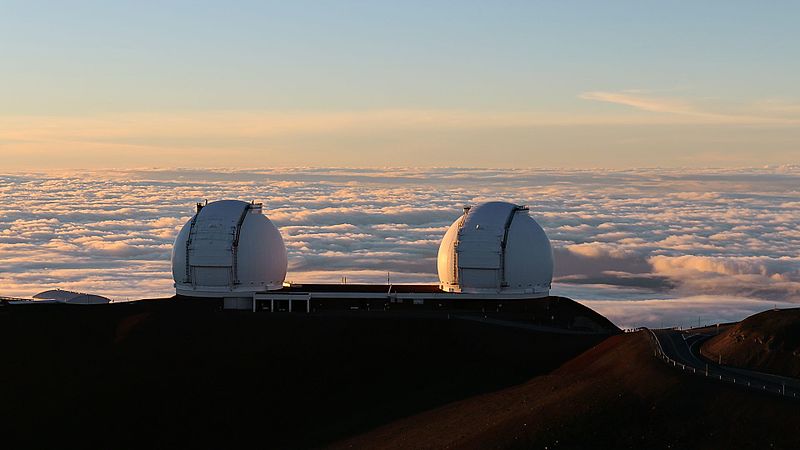
Wikimedia
On Hawaii’s Mauna Kea volcano, hundreds of Native Hawaiian activists, scholars and scientists are resisting the construction of a new, massive telescope that may soon become the 14th built on the cultural and religious site — a stand that has received nationwide support, including endorsements by New York Congresswoman Alexandria Ocasio-Cortez and Massachusetts Senator Elizabeth Warren.
Blocking off access to the mountain for over a week, the activists have so far prevented construction of the 18-story Thirty Meter Telescope, or TMT, and its 5-acre facility.
The TMT project is spearheaded by the California Institute of Technology and the University of California system, among others. Yale, unlike these institutions, is not a financier or policymaker of the TMT: Professors said the University decided to not pay for department observation time on the TMT due to the multimillion dollar price tag.
Still, the University is affiliated with the project as a member institution of the Association of Universities for Research in Astronomy, or AURA, which has provided scientific guidance to the main TMT financiers and policymakers. In addition, Yale’s Astronomy Department has relied on two Mauna Kea telescopes — Keck I and Keck II — for over a decade.
Native Hawaiians have sharply opposed construction of any kind on Mauna Kea for over 50 years, and their movement draws into question the ethics of conducting research with telescopes built on the mountain. Activists say that construction on Mauna Kea violates indigenous rights, harms the fragile Mauna Kea ecosystem and ignores the mountain’s significance to Native Hawaiian culture and religion. Scientists, however, contend that the roughly 14,000-foot summit is prime telescope real estate — one of the best viewing sites in the world due to its high altitude, minimal light pollution and clear weather conditions.
In the wake of recent high-profile activism on Mauna Kea mirroring that of 2015 — as well as condemnation from University students and groups like the Association of Native Americans at Yale — the Astronomy Department issued a response Friday stating it is “concerned over the situation at Mauna Kea” and hopes it “will be resolved locally and peacefully.”
Still, about half of professors in the astronomy department has conducted research with Mauna Kea’s Keck I and Keck II telescopes for years, according to an astronomy professor who spoke on the condition of anonymity. Astronomy Department Chair Sarbani Basu said that the University buys between 24 and 25 observation nights on the telescopes, and has invested at least $12 million into the facility’s operation through a 2009 deal made with the California Institute of Technology.
Two Yale astronomy professors — Meg Urry and the anonymous professor — told the News this week that the department never held a formal meeting to discuss the ethics of using Mauna Kea telescopes for their own research. The anonymous professor said many in the department had thoughts on the practice, but discussing Yale’s hand in the situation never rose to more than “people talking to each other over coffee.”
When asked why the ethical considerations of using the Keck telescopes on Mauna Kea were never formally discussed, department chair Sarbani Basu responded in a Thursday email, “I am not sure what you mean. There was never anything remotely iffy about Keck!”
“The Keck telescope had been operating for years before we decided to buy nights, so no, there was nothing to discuss,” Basu wrote.
When it comes to discontinuing their use of Mauna Kea telescopes, several astronomy professors told the News that their hands are tied: Without access to the cutting-edge telescopes — an astronomer’s lab space — the department would slip in rank. Urry said some still hope a deal can be made with Caltech to gain access to TMT at a lower cost.
“We have wanted access to one of the 30 meter-type telescopes, either TMT or GMT [in Chile],” Basu wrote in an email to the News. “We were told by the Provost’s office that the money required is too much. Without such access in the future, we are in danger of again becoming a second-tier department.”
Yale students have taken to social media to voice their condemnation of the University’s use of telescopes on Mauna Kea as well as the University’s affiliation to AURA, the body providing scientific guidance on the TMT project to the telescope’s main partners.
Native American Cultural Center staff member and Native Hawaiian student Micah Clemens Kulanakilaikekai’ale’ale Young ’21 wrote an open letter to the Astronomy Department on Wednesday asking its professors to speak out against the TMT.
“I understand that this is a long, bureaucratic process,” he wrote, “but I also understand that Yale is committed to Light and Truth.”
Young told the News that the letter — shared widely on social media — has been successful in changing perspectives of some professors in the astronomy department. Still, he said that he does “not need nor deserve the limelight granted to me through the letter. I do not have the wisdom of a kupuna.”
When asked by the News how he felt about Yale’s use of the Keck telescopes and the lack of conversations within the department, Young said that overall he is looking forward to what he called a much needed discussion. He hopes it will dispel misinformation circulating in the press.
“I do recognize that a meeting of this nature must be done as an entire department and in person,” he said. “These two factors are incredibly difficult during the summer.”
NACC Director Matthew Makomenaw did not respond to a request for comment.
The Association of Native Americans at Yale has organized a virtual letter writing event that urges the Yale community to pressure the Astronomy Department to withdraw support for construction of the TMT and hold Yale “accountable for its part in the colonial violence against Kanaka Maoli (Native Hawaiians) and their environment.”
The Astronomy Department operates the Leiner Observatory, a facility on Yale’s campus.
Marisa Peryer | marisa.peryer@yale.edu







